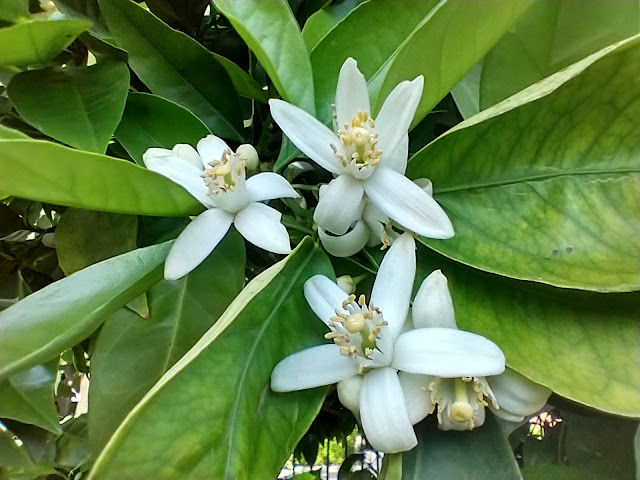
Rain coming soon -- but how much?

|
|
Orange trees are blooming, including this one in Midtown Sacramento. The blossoms are a reminder to give the trees a low dose of balanced fertilizer. (Photo:
Debbie Arrington)
|
Sacramento can (finally) expect more rain Monday, maybe even Sunday evening. But how much?
According to the National Weather Service, estimates are just that – estimates. This fast-moving storm system could drop as much as an inch of rain on Sacramento – or just 0.10.
Most likely, it will be somewhere in between those amounts. As of late Friday night, the weather service pegs Sacramento's total at 0.62 inches with “definite rain showers and thunderstorms” forecast throughout Monday.
Otherwise, our final days of March will stay mostly on the warm side with afternoons in the mid 70s while overnight lows will keep dipping into the 40s.
Expect more of the same for at least a little while. April in Sacramento averages highs of 71 degrees and lows of 46.
* Smell orange blossoms? Feed citrus trees with a low dose of balanced fertilizer (such as 10-10-10) during bloom to help set fruit. Keep an eye out for ants.
* Early spring is the last chance to plant citrus trees such as dwarf orange, lemon and kumquat. These trees also look good in landscaping and provide fresh fruit in winter.
* Apply slow-release fertilizer to the lawn.
* Watch out for powdery mildew and other fungal diseases.
* Knock aphids off plants with a strong blast of water.
* Thoroughly clean debris from the bottom of outdoor ponds or fountains.
* Spring brings a flush of rapid growth, and that means your garden is really hungry. Feed shrubs and trees with a slow-release fertilizer. Or mulch with a 1-inch layer of compost.
* Azaleas and camellias looking a little yellow? If leaves are turning yellow between the veins, give them a boost with chelated iron.
* Trim dead flowers but not leaves from spring-flowering bulbs such as daffodils and tulips. Those leaves gather energy to create next year's flowers. Also, give the bulbs a fertilizer boost after bloom.
* Transplant lettuce and cabbage seedlings.
* Gradually expose tomato and pepper seedlings to outdoor conditions, starting with a few hours in morning sun. As soil warms, these "hardened off" transplants can go in the ground.
* From seed, plant beets, carrots, chard, chives, fennel, mustard, radishes, squash and turnips. Plant seed potatoes.
* In the flower garden, plant seeds for asters, cosmos, celosia, marigolds, salvia and sunflowers.
* Transplant petunias, geraniums and other summer bloomers.
* Plant perennials and dahlia tubers for summer bloom.
Comments
0 comments have been posted.Sacramento Digs Gardening to your inbox.
Sites We Like
Garden Checklist for week of July 21
Your garden needs you!
* Keep your vegetable garden watered, mulched and weeded. Water before 8 a.m. to reduce the chance of fungal infection and to conserve moisture.
* Feed vegetable plants bone meal, rock phosphate or other fertilizers high in phosphate to stimulate more blooms and fruiting. (But wait until daily high temperatures drop out of the 100s.)
* Don’t let tomatoes wilt or dry out completely. Give tomatoes a deep watering two to three times a week.
* Harvest vegetables promptly to encourage plants to produce more. Squash especially tends to grow rapidly in hot weather. Keep an eye on zucchini.
* Pinch back chrysanthemums for bushy plants and more flowers in September.
* Remove spent flowers from roses, daylilies and other bloomers as they finish flowering.
* Pinch off blooms from basil so the plant will grow more leaves.
* Cut back lavender after flowering to promote a second bloom.
* It's not too late to add a splash of color. Plant petunias, snapdragons, zinnias and marigolds.
* From seed, plant corn, pumpkins, radishes, winter squash and sunflowers.